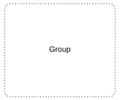| event | - start (none, message, timer, rule, link, multiple)
- intermediate (none, message, timer, error, cancel, compensation, rule, link, multiple)
- end (none, message, error, cancel, compensation, link, terminate, multiple)
| - start (none, message, timer, conditional, signal, multiple)
- intermediate (none, message, timer, error, cancel, compensation, conditional, link, signal, multiple)
- end (none, message, error, cancel, compensation, signal, terminate, multiple)
| - start
- top-level (none, message, timer, conditional, signal, multiple, parallel multiple)
- event sub-process interrupting (message, timer, escalation, conditional, error, compensation, signal, multiple, parallel multiple)
- event sub-process non-interrupting (message, timer, escalation, conditional, signal, multiple, parallel multiple)
- intermediate
- catching (message, timer, conditional, link, signal, multiple, parallel multiple)
- boundary interrupting (message, timer, escalation, conditional, error, cancel, compensation, signal, multiple, parallel multiple)
- boundary non-interrupting (message, timer, escalation, conditional, signal, multiple, parallel multiple, terminate)
- throwing (none, message, escalation, link, compensation, signal, multiple, parallel multiple)
- end (none, message, escalation, error, cancel, compensation, signal, multiple, terminate)
|
| Major changes | — | - The new specification introduces a categorization of event triggers into "catching" and "throwing" events. I.e. there are two kinds of intermediate message events now – one kind responsible for reception of messages ("catching") and one kind responsible for sending messages ("throwing").
- In addition to the old types, it introduces a new type, the signal event.
- Start and end link events do not exist any longer in BPMN 1.1.
- The old "rule events" were renamed to conditional events. The semantics and appearance have not changed.
- The event-based gateway in BPMN 1.1 looks slightly different from what it looked like in 1.0. Instead of the hexagonal star it now has a pentagon in its center. The same shape is also used for the multiple events (start, intermediate, end).
- There is an additional line separating your lane's description from its content.
| The BPMN 1.2 minor revision changes consist of editorial corrections and implementation bug fixes. Consequently, these minor changes affect modeling tool vendors more than modelers (users). [7] | - Choreographies
- Choreographies-model
- Conversation-model
- Complete Metamodel
- BPMN Core
- BPMN Execution Semantics
- BPMN – BPEL Mapping
- XPDL (BPMN XML Serialization)
- Diagram Interchange
- Elements For Abstraction
- Callable Element
- Call Activity
- Global Task
- Gateways (Updated)
- Exclusive/Parallel Event-based Gateway (they stand at the beginning of the process)
- Tasks/SubProcesses (Updated)
- Event-Subprocess (Used to handle events in the bounding subprocess)
- BusinessRule task
- Sequential Multi-Instance Activity
- Service Task
- Artifacts (Updated)
- Data Objects (Collection, Data Input, Data Output)
|









